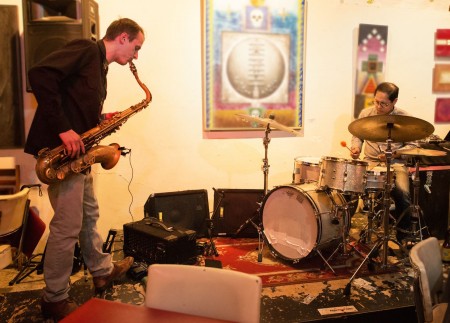Buddy Catlett, Seattle jazz legend, dies
 Note: Make sure and pick up a copy of Saturday’s print edition of The Seattle Times for obituary on Buddy Catlett
Note: Make sure and pick up a copy of Saturday’s print edition of The Seattle Times for obituary on Buddy Catlett
From The Seattle Times:
George James “Buddy” Catlett, one of the most illustrious musicians to come up on Seattle’s Jackson Street jazz scene of the 1940s, died Wednesday, Nov. 12. Catlett was 81. He had been living at the Leon Sullivan Health Care Center in Seattle’s Central District and had not performed for some time.
Best known as a swinging, “in the pocket” bassist with a muscular, full-bodied sound, Mr. Catlett anchored the bands of Count Basie, Quincy Jones and Louis Armstrong for long stints, recording with them, as well.
Born in Long Beach, Pacific County, Mr. Catlett grew up in Seattle and came from a family of black pioneers that traces its history back to the early 1900s. The diminutive, rotund musician — nicknamed “Bumblebee” by his friends — attended Garfield High School and started out on alto saxophone, which he played with Jones in a band led by their classmate, Charles Taylor. However, in 1950, the young sax man was struck with pleurisy, which his doctor feared was tuberculosis, so he was advised to stop playing a wind instrument. This led to his taking up the bass fiddle.
After “paying his dues” in local bands led by trumpeter Floyd Standifer and others, Catlett left town in 1956 to join Horace Henderson (Fletcher Henderson’s brother). Mr. Catlett subsequently worked with guitarist Johnny Smith and Latin vibraphonist Cal Tjader. In 1959, the bassist’s former classmate Jones hired Mr. Catlett in a new big band, which Jones took to Europe as part of a musical called “Free and Easy,” starring Sammy Davis Jr. The show folded after a few performances, but the band — which also featured Standifer and Seattle pianist Patti Bown — stayed in Europe for eight months.
Jones’ big band — legendary in the annals of modern jazz and rivaled at the time by only Basie and Ellington – was economically unsustainable, but it nevertheless recorded highly-regarded albums, notably “Birth of a Band.” With Basie, Mr. Catlett also recorded a classic album with Frank Sinatra, “With Rose Colored Glasses,” and subsequently worked with pianists Red Garland and JuniorMance, drummer Chico Hamilton and saxophonists Coleman Hawkins, Johnny Griffin and Eddie “Lockjaw” Davis.
In the late ’60s, Mr. Catlett was hired by Armstrong, with whom he played, recorded and toured until 1969.
Throughout his early life and middle age, Mr. Catlett struggled with alcohol. In the ’70s, when jazz work became scarce, he dropped out of music for a while, and decided to come back to Seattle to recover. Gradually, he re-entered the jazz world on the home front, becoming an important part of the local scene, working at now-defunct clubs such as the New Orleans Restaurant and Lofurno’s, where national figures from his days on the road, such as Clark Terry and Jones, would regularly drop by. His accomplishments were celebrated by the Seattle jazz non-profit Earshot Jazz when it inducted Mr. Catlett into the Seattle Jazz Hall of Fame, in 1991.
 Town Hall Seattle, 8pm
Town Hall Seattle, 8pm Tula’s Restaurant & Jazz Club, 7:30pm
Tula’s Restaurant & Jazz Club, 7:30pm

 PONCHO Concert Hall, Cornish College of the Arts, 8pm
PONCHO Concert Hall, Cornish College of the Arts, 8pm Triple Door, 7:30pm
Triple Door, 7:30pm


 Tula’s Restaurant & Jazz Club, 7:30pm
Tula’s Restaurant & Jazz Club, 7:30pm Royal Room, 8pm
Royal Room, 8pm Chapel Performance Space, 8pm
Chapel Performance Space, 8pm Nordstrom Recital Hall, 7:30pm
Nordstrom Recital Hall, 7:30pm